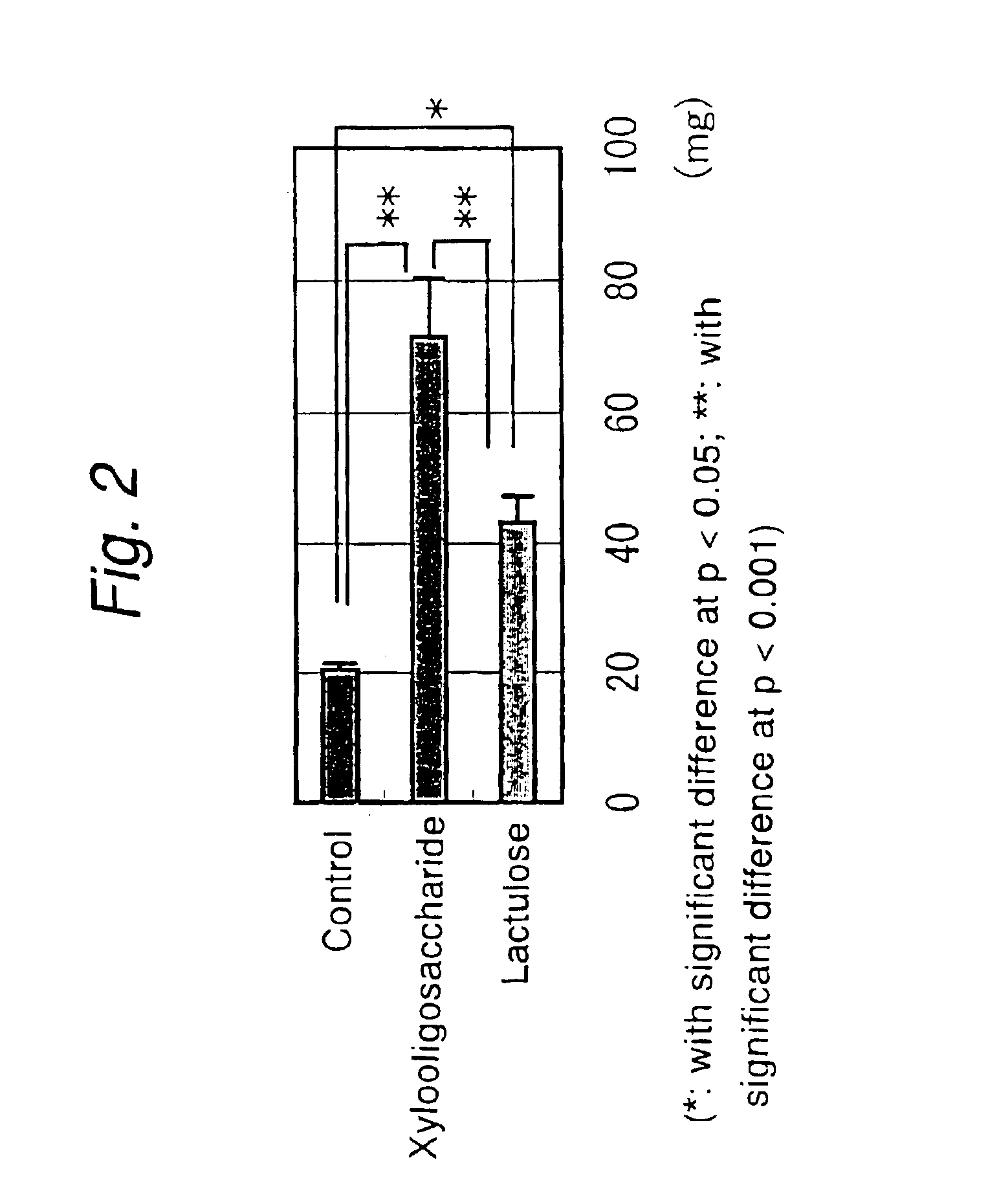Remedies for hyperammonemia
a technology of blood ammonia and treatment agents, which is applied in the field of blood ammonia lowering agents as well as therapeutic agents for hyperammonemia or hepatic encephalopathy, can solve the problems of reducing net atp production, affecting the maintenance of this minimum maintenance level of protein, and affecting the maintenance of hyperammonemia, so as to achieve the effect of reducing blood ammonia levels and significantly lowering blood ammonia levels
- Summary
- Abstract
- Description
- Claims
- Application Information
AI Technical Summary
Benefits of technology
Problems solved by technology
Method used
Image
Examples
example 1
Effects of Xylooligosaccharide on Rats Feeding on High-Protein Diet
[0043]As is known, when a high-protein diet is taken, the urea level in the blood and cecum increases, eventually elevating the blood ammonia level. The effect of xylooligosaccharide on N excretion from rats feeding on a high-protein diet was investigated and there was made a comparison with lactulose conventionally used in treatment of hepatic encephalopathy.
[0044]SD Male rats in a growth stage (20 heads) were fed on a high-protein feed (containing 50% casein) and divided in three groups; the first group consisting of 7 rats were administered xylooligosaccharide (2% aq. sol.) containing 42 wt % xylobiose; the second group also consisting of 7 rats were administered lactulose (2% aq. sol.); the third was a control group consisting of 6 rats which were administered distilled water; the animals were let to drink these liquids ad libitum for 3 weeks. Throughout the test period, there were no effects on the amounts of fe...
example 2
Effects of Xylobiose on Rats Feeding on High-Protein Diet
[0049]SD Male rats in a growth stage (15 heads) were fed on a high-protein feed (containing 50% casein) and divided in three groups; the first group consisting of 5 rats were administered 0.5% xylobiose; the second group also consisting of 5 rats were administered 1.0% xylobiose; the third was a control group consisting of 5 rats which were administered distilled water; the animals were let to drink these liquids ad libitum for 3 weeks. Throughout the test period, there were no effects on the amounts of feed and water taken by the rats and the increase in their body weight. The cumulative uptake was 4.7±0.2 g for 0.5% xylobiose and 7.5±0.6 g for 1.0% xylobiose; the daily uptake by the two groups was 0.24 g and 0.37 g, respectively.
[0050]At the end of the test, blood was sampled from the rats and the blood ammonia level was measured.
[0051]As FIG. 6 shows, the blood ammonia level in the rats administered xylobiose was lower than...
example 3
Effect of Xylooligosaccharide on Patients with Hepatic Encephalopathy (i)
[0053]Patients with cirrhosis who did not involve overt encephalopathy and who showed sub-high blood ammonia levels were asked to take 3 g of xylooligosaccharide daily for 4-8 weeks. The sacchardie composition was as follows on a weight basis: about 34% of xylobiose: about 39% of xylotriose or higher oligomer; about 26% of xylose; and about 1% of others. Two weeks later, the blood ammonia level was measured. In the five cases of cirrhosis, the blood ammonia level dropped significantly as the result of administering xylooligosaccharide (initial value: 90.8±29.2 μmol / L; after 2 wk of administration: 45.0±13.3 mmol / L). There were observed no particular side effects of xylooligosaccharide.
PUM
| Property | Measurement | Unit |
|---|---|---|
| wt % | aaaaa | aaaaa |
| concentration | aaaaa | aaaaa |
| body weight | aaaaa | aaaaa |
Abstract
Description
Claims
Application Information
 Login to View More
Login to View More - R&D
- Intellectual Property
- Life Sciences
- Materials
- Tech Scout
- Unparalleled Data Quality
- Higher Quality Content
- 60% Fewer Hallucinations
Browse by: Latest US Patents, China's latest patents, Technical Efficacy Thesaurus, Application Domain, Technology Topic, Popular Technical Reports.
© 2025 PatSnap. All rights reserved.Legal|Privacy policy|Modern Slavery Act Transparency Statement|Sitemap|About US| Contact US: help@patsnap.com



